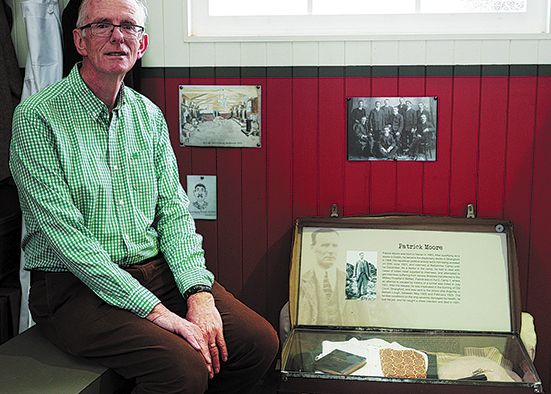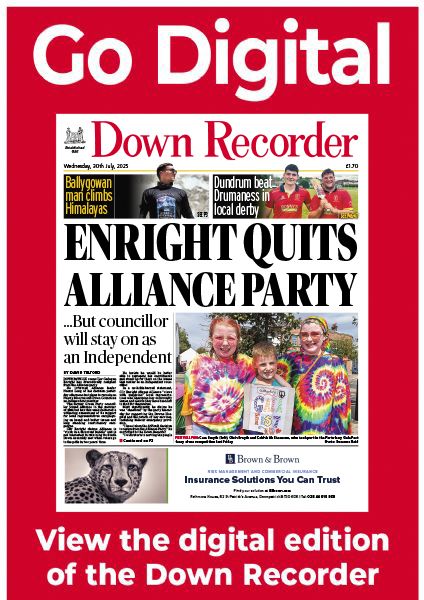From the cradle to the grave – Down County Museum medical collection
From the cradle to the grave – Down County Museum medical collection
18 May 2022

MY family has been serving the local area as general practitioners since my grandfather came to Strangford a short time after he graduated in 1905, when he was employed as a dispensary doctor.
It was two years after his death in 1931 that my father took over the practice. It was five years after his retirement in 1975 that I joined Dr Nicholas Napier in the same practice and my son, David, has continued the tradition since I retired in 2014.
I visited the Down County Museum in 1998, when the National Health Service was celebrating its 50th anniversary and a small exhibition was being held to display a selection of medical items from their collection.
Following this, in 1999, a catalogue of the entire medical collection was published by Madeleine McAllister and Lesley Simpson. This demonstrated the wide range of material, from objects relating to home treatments, to early public health and professional medicine, to later objects from the time of the National Health Service and from the voluntary services.
The collection was added to by other families and the South Eastern Health and Social Care Trust (SEHSCT). One contribution was from the family of a local doctor who had served in India, demonstrating County Down connections to a wider world and putting medical work in a very different context.
I was lucky enough to have been given the opportunity several years ago to view the whole collection, as it was then, laid out in one large room in the museum and it was amazing. I was especially pleased to reacquaint myself with some of the donations that had belonged to my late father, items that he had used over the years in his general practice surgery at Corbally Hill.
It still makes me smile to recall his enthusiasm and delight as he showed me his new haemoglobinometer, an instrument that allowed him to check if a patient had anaemia without having to send a blood sample to the laboratory.
Since then, the old Downe Hospital was closed, and museum staff were given over 30 boxes of medical instruments, documents and photographs by the SEHSCT. They were roughly sorted and an exhibition was created soon afterwards in order to show just a few of these newly acquired objects.
However, it was made clear at the time that this was merely the tip of a very large iceberg. The sheer scale of the donation, given at a time when curatorial staff were busy with a major capital building project to house new galleries at the rear of the cell block, meant that the items had to await full documentation until curatorial staff were free to take on such an immense task. Some of this documentation has now been completed, but a huge amount of work remains to be done.
The collection includes such diverse items as Rev John Wesley’s Primitive Physic: or an easy and natural way of curing most diseases, published in 1802, wrapping paper printed with an advertisement for Beecham’s Pills, the name of Shield’s Medical Hall, Irish Street, Downpatrick, and a piece of red flannel used for wrapping round the chest to cure colds. Many older people will find this last item very familiar and I myself occasionally visited patients who had to remove the red flannel before I could examine their chest.
It also contains Red Cross and St John Ambulance Association uniforms and a set of medical instruments which belonged to Alexander Leslie Gracey of Ballyhosset, The documents held by the museum include an architect’s drawing of the ‘Down Lunatic Asylum’, dated 1883 and a copy of the Beveridge Report in Brief, published in 1942 with a leaflet about the new Health Service.
Local people would recognise the names of well-known surgeons such as John Robb and John Boyd along with doctors who are perhaps less well known: Alexander Gracey, John Maconchy, Thomas Cromie and Jack Jordan. Photographs from the Museum’s D J McNeill Collection along with others more recently acquired will be especially useful for prompting memories.
The challenge now is to fully document these objects, to continue the research and collect the oral records. From this combined information, with professional expertise and community involvement it will be possible to create a much bigger and informative exhibition in the future.
How much of this will be possible if the proposed changes to the curatorial staffing levels in the museum are realised? The importance of the medical collection to the museum and to the local community cannot be overstated: Downpatrick has been at the centre, and indeed, forefront of medical practice and innovation for over 200 years. My own family aside, there are many people who will identify closely with the collection, whether as patients or medical and non-medical staff.
The local community deserves to have the many collections held in the Down Museum, including the Medical Collection, treated with respect. The collection and the local community are inseparable.


